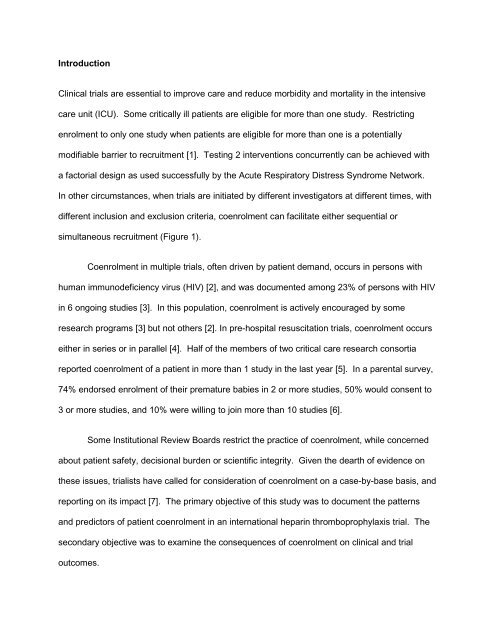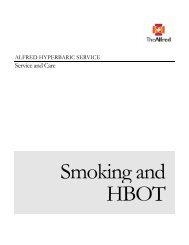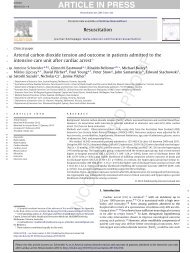Critical Care
See Full Article - Alfred Intensive Care Unit
See Full Article - Alfred Intensive Care Unit
- No tags were found...
You also want an ePaper? Increase the reach of your titles
YUMPU automatically turns print PDFs into web optimized ePapers that Google loves.
Introduction<br />
Clinical trials are essential to improve care and reduce morbidity and mortality in the intensive<br />
care unit (ICU). Some critically ill patients are eligible for more than one study. Restricting<br />
enrolment to only one study when patients are eligible for more than one is a potentially<br />
modifiable barrier to recruitment [1]. Testing 2 interventions concurrently can be achieved with<br />
a factorial design as used successfully by the Acute Respiratory Distress Syndrome Network.<br />
In other circumstances, when trials are initiated by different investigators at different times, with<br />
different inclusion and exclusion criteria, coenrolment can facilitate either sequential or<br />
simultaneous recruitment (Figure 1).<br />
Coenrolment in multiple trials, often driven by patient demand, occurs in persons with<br />
human immunodeficiency virus (HIV) [2], and was documented among 23% of persons with HIV<br />
in 6 ongoing studies [3]. In this population, coenrolment is actively encouraged by some<br />
research programs [3] but not others [2]. In pre-hospital resuscitation trials, coenrolment occurs<br />
either in series or in parallel [4]. Half of the members of two critical care research consortia<br />
reported coenrolment of a patient in more than 1 study in the last year [5]. In a parental survey,<br />
74% endorsed enrolment of their premature babies in 2 or more studies, 50% would consent to<br />
3 or more studies, and 10% were willing to join more than 10 studies [6].<br />
Some Institutional Review Boards restrict the practice of coenrolment, while concerned<br />
about patient safety, decisional burden or scientific integrity. Given the dearth of evidence on<br />
these issues, trialists have called for consideration of coenrolment on a case-by-base basis, and<br />
reporting on its impact [7]. The primary objective of this study was to document the patterns<br />
and predictors of patient coenrolment in an international heparin thromboprophylaxis trial. The<br />
secondary objective was to examine the consequences of coenrolment on clinical and trial<br />
outcomes.









